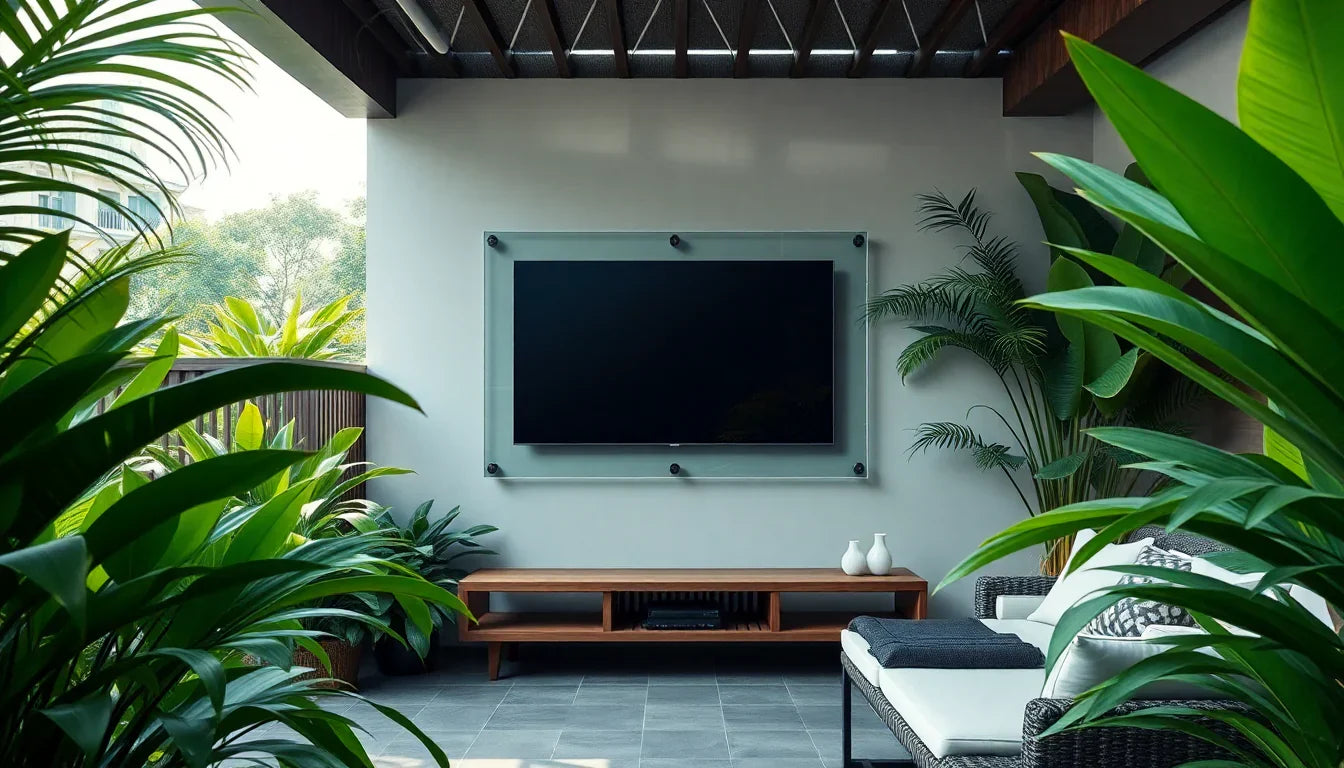
How to protect Outdoor TV Enclosures from humidity
Humidity poses a significant threat to outdoor TV enclosures, making protection essential for maintaining their functionality. Without adequate safeguards, moisture can lead to severe consequences: corrosion of internal components, malfunctioning circuits, and screen issues like discoloration or pixel damage. Over time, these problems reduce the lifespan of the enclosure and the TV itself. Proactive measures, such as selecting durable materials and ensuring proper sealing, enhance durability and performance. By addressing humidity risks early, users can prevent costly repairs and enjoy uninterrupted entertainment in outdoor spaces.
Key Takeaways
-
Pick weatherproof cases with a high IP rating to stop water and dust.
-
Use dehumidifiers or silica gel packs to reduce moisture inside.
-
Check and clean the case often to avoid dirt and water damage.
-
Seal cable holes well to keep water out of the case.
-
Choose strong materials like aluminum or good plastic for lasting safety.
Understanding the Risks of Humidity
Effects of Humidity on Outdoor TVs
Corrosion and electrical damage
Humidity poses a significant threat to outdoor TVs by introducing moisture into their internal components. When humid air contacts cooler surfaces, condensation forms, leading to potential harm. Moisture can corrode critical parts like circuit boards and connectors, causing irreversible damage. Over time, this corrosion compromises the TV's functionality, resulting in frequent malfunctions or complete failure. Additionally, moisture can create electrical shorts, which may cause the TV to shut down unexpectedly or fail to power on entirely. These issues highlight the importance of protecting outdoor TVs from excessive humidity.
Reduced performance and lifespan
High humidity levels can severely impact the performance and longevity of outdoor TVs. Moisture buildup within the screen often leads to discoloration or permanent pixel damage. This not only affects the viewing experience but also reduces the TV's overall lifespan. Electronics, including TVs, are not designed to function optimally in moist environments. Prolonged exposure to humidity accelerates wear and tear, making regular maintenance and protective measures essential for preserving performance.
Impact on Outdoor TV Enclosures
Mold and mildew growth
Outdoor TV enclosures are not immune to the effects of humidity. Excess moisture creates an ideal environment for mold and mildew growth. These fungi can spread quickly, damaging the enclosure's interior and exterior surfaces. Mold not only affects the enclosure's appearance but also poses health risks to individuals nearby. Preventing moisture accumulation inside the enclosure is crucial to avoid these problems.
Material degradation and structural weakening
Humidity can degrade the materials used in outdoor TV enclosures over time. Prolonged exposure to moisture weakens structural components, reducing the enclosure's ability to protect the TV. Materials like metal may corrode, while plastics can become brittle and crack. This degradation compromises the enclosure's durability, leaving the TV vulnerable to further damage. Choosing high-quality, weather-resistant enclosures helps mitigate these risks and ensures long-term protection.
Choosing the Right Outdoor TV Enclosures
Essential Features of Weatherproof Enclosures
Waterproof and sealed designs
A reliable outdoor TV enclosure must feature a waterproof and sealed design to protect against rain, snow, and humidity. Enclosures with a high Ingress Protection (IP) rating, such as IP55 or higher, offer superior resistance to water and dust. These designs prevent moisture from seeping into the enclosure, safeguarding the TV's internal components. Additionally, weatherproof enclosures often include thermal control systems to maintain optimal temperatures, ensuring the TV operates efficiently in various climates.
UV-resistant and durable materials
UV-resistant materials are essential for outdoor TV enclosures to withstand prolonged exposure to sunlight. These materials prevent fading, cracking, and warping caused by UV rays. Durability is equally important, as the enclosure must resist rust, corrosion, and physical damage. Features like anti-glare screens and security locks further enhance the enclosure's functionality, providing a comprehensive solution for outdoor entertainment setups.
Recommended Materials for Enclosures
Aluminum and stainless steel
Aluminum and stainless steel are excellent choices for outdoor TV enclosures due to their durability and resistance to corrosion. Aluminum is lightweight and rust-resistant, making it ideal for humid environments. Stainless steel offers a sleek appearance and exceptional strength, though it may be more expensive. Both materials provide long-lasting protection against weather elements, ensuring the TV remains secure and functional.
High-quality plastic or polymer
High-quality plastics, such as polycarbonate, are another effective option for outdoor TV enclosures. These materials are UV-resistant, lightweight, and capable of withstanding extreme temperatures. Polycarbonate enclosures also offer high impact resistance, reducing the risk of damage from accidental impacts. While minor scratches may occur, they are easy to clean and maintain, making them a practical choice for outdoor use.
|
Material |
Advantages |
Disadvantages |
|---|---|---|
|
Aluminum |
Lightweight, durable, rust and corrosion resistant |
Low impact resistance, may dent easily |
|
Polycarbonate |
High impact resistance, UV resistant, withstands extreme temperatures |
Mild scratches may occur, easily cleaned |
|
Stainless Steel |
Durable, aesthetically pleasing |
Corrodes easily, can be expensive |
Advantages of High-Quality Enclosures
Long-term cost savings
Investing in a high-quality outdoor TV enclosure reduces long-term costs by minimizing the need for repairs and replacements. Durable materials and weatherproof designs protect the TV from environmental damage, extending its lifespan. This proactive approach eliminates the expenses associated with frequent maintenance or purchasing new equipment.
Comprehensive protection against weather elements
High-quality enclosures provide comprehensive protection against various weather elements, including rain, humidity, and UV rays. Features like anti-reflective screens and thermal control systems enhance the viewing experience while maintaining the TV's performance. By choosing a robust enclosure, users can enjoy uninterrupted entertainment in outdoor spaces, regardless of the weather conditions.
Additional Protective Measures
Using Dehumidifiers and Moisture Absorbers
Benefits of portable dehumidifiers
Portable dehumidifiers offer an effective solution for managing humidity levels inside outdoor TV enclosures. These devices extract excess moisture from the air, reducing the risk of condensation and corrosion. Compact and energy-efficient models are ideal for outdoor setups, as they can operate continuously without consuming significant power. By maintaining a dry environment, dehumidifiers help preserve the TV's performance and extend its lifespan.
Placement and usage of silica gel packets
Silica gel packets provide a low-cost yet efficient method for absorbing moisture within enclosures. Placing these packets strategically near vulnerable areas, such as cable entry points or ventilation openings, enhances their effectiveness. Regularly replacing the packets ensures consistent moisture control. Combining silica gel with other protective measures creates a comprehensive defense against humidity.
Sealing Techniques for Enhanced Protection
Weatherproof gaskets and seals
Weatherproof gaskets and seals are essential for preventing moisture infiltration. High-quality rubber or silicone gaskets create a tight barrier around the enclosure's edges, blocking water and humid air. These seals also protect against dust and debris, ensuring the enclosure remains clean and functional. Regular inspection and replacement of worn-out gaskets maintain their effectiveness over time.
Properly sealing cable entry points
Cable entry points are common weak spots in outdoor TV enclosures. Improper sealing can allow moisture to seep inside, leading to potential damage. Using specialized cable glands or sealant materials ensures a secure fit around cables, preventing water ingress. This simple yet crucial step significantly enhances the enclosure's overall protection.
Incorporating Temperature-Controlled Heaters
Preventing condensation with controlled heating
Temperature-controlled heaters play a vital role in preventing condensation inside outdoor TV enclosures. These heaters stabilize the internal environment, especially in freezing conditions. They prevent the TV from becoming too cold, which could lead to condensation and potential damage. Proper ventilation complements the heater's function by promoting airflow and further reducing moisture buildup.
Maintaining optimal internal temperature
Maintaining a stable internal temperature is critical for the longevity of outdoor TVs. Temperature-controlled heaters regulate the enclosure's climate, ensuring the TV operates efficiently in extreme weather. This feature minimizes the risk of overheating or freezing, providing consistent performance throughout the year. Combining heaters with basic ventilation creates an ideal environment for the TV.
Installation and Maintenance Tips

Best Practices for Installation
Selecting an ideal location with minimal exposure
Choosing the right location is critical for minimizing humidity exposure. Placing outdoor TV enclosures in a sheltered area, such as under a patio roof or pergola, reduces direct contact with rain and sunlight. A dedicated outdoor entertainment space with partial coverage offers additional protection. Weather-resistant TV mounts and cabinets further enhance durability, ensuring the enclosure remains secure in varying conditions.
Ensuring proper ventilation to avoid overheating
Proper ventilation prevents overheating, which can damage both the TV and the enclosure. Enclosures with built-in vents or fans promote air circulation, maintaining an optimal internal temperature. When installing, ensure the enclosure is not placed against walls or other obstructions that could block airflow. This setup helps regulate humidity levels and prevents condensation buildup inside the enclosure.
Regular Maintenance Routines
Cleaning and inspecting the enclosure
Regular cleaning is essential to maintain the effectiveness of outdoor TV enclosures. Use mild cleaning solutions to remove dirt, dust, and debris without scratching the surface. Inspect the enclosure for signs of wear, such as cracks or rust, and address these issues promptly. Consistent cleaning and inspection prevent long-term damage and ensure the enclosure remains functional.
Replacing worn-out seals and gaskets
Seals and gaskets play a vital role in keeping moisture out of the enclosure. Over time, these components may degrade, reducing their effectiveness. Regularly check for cracks or gaps in the seals and replace them as needed. High-quality rubber or silicone gaskets provide a reliable barrier against humidity, extending the lifespan of the enclosure and the TV.
Seasonal Adjustments for Humidity
Preparing for high-humidity seasons
High-humidity seasons require additional precautions to protect outdoor TV enclosures. Enclosures with vents and fans help control moisture levels by promoting air circulation. For areas with extreme humidity, consider using dehumidifiers or silica gel packets inside the enclosure. These measures prevent condensation and reduce the risk of mold growth.
Storing the TV during extreme weather conditions
In regions prone to severe weather, storing the TV indoors during extreme conditions is a practical solution. While high-quality enclosures provide robust protection, prolonged exposure to heavy rain or storms can still pose risks. Removing the TV and storing it in a dry, safe location ensures its longevity and performance. Reinstalling the TV after the weather stabilizes minimizes potential damage.
Common Mistakes to Avoid
Using Non-Weatherproof Enclosures
Risks of using indoor enclosures outdoors
Using non-weatherproof enclosures for outdoor TVs exposes the equipment to significant risks. Outdoor environments present challenges that indoor enclosures cannot withstand.
-
Weather Conditions: Rain, wind, and extreme temperatures can damage the TV and its mounting hardware. Non-weatherproof enclosures fail to provide adequate protection, leading to moisture infiltration and structural instability.
-
Theft and Vandalism: Indoor enclosures lack the robust security features needed for outdoor setups. This vulnerability increases the risk of theft or intentional damage.
-
Structural Integrity: Non-weatherproof enclosures may not securely attach to outdoor structures. Weak mounts can lead to accidents, especially during strong winds or storms.
-
Electrical Safety: Outdoor environments heighten the risk of electrical hazards. Non-weatherproof designs fail to shield cables and connections from moisture, increasing the likelihood of short circuits.
Selecting a weatherproof enclosure ensures comprehensive protection against these risks, safeguarding both the TV and its surroundings.
Neglecting Regular Maintenance
Consequences of ignoring inspections and cleaning
Neglecting regular maintenance compromises the performance and longevity of outdoor TV enclosures. Several issues arise when inspections and cleaning are overlooked:
-
Dust, dirt, and debris accumulate over time, affecting the enclosure's functionality and the TV's performance.
-
Moisture damage becomes more likely without routine checks, leading to corrosion and mold growth.
-
Overheating issues develop as ventilation systems become clogged or obstructed.
-
The lifespan of both the TV and the enclosure decreases significantly due to neglect.
To avoid these problems, follow a consistent maintenance routine:
-
Clean the enclosure regularly to prevent dust and debris buildup.
-
Inspect for cracks, rust, or other damage to ensure the enclosure remains protective.
-
Replace worn-out seals and gaskets to maintain a moisture-resistant barrier.
Proactive maintenance enhances the durability and efficiency of outdoor TV setups.
Overlooking Proper Ventilation
How poor airflow leads to condensation buildup
Proper ventilation is essential for preventing condensation inside outdoor TV enclosures. Poor airflow traps humid air, creating an environment where moisture condenses on internal surfaces. This condensation leads to corrosion, mold growth, and electrical malfunctions.
Enclosures with built-in vents or fans promote air circulation, reducing humidity levels. When installing, ensure the enclosure is not placed against walls or other obstructions that block airflow. A well-ventilated setup prevents condensation buildup, protecting the TV and maintaining its performance over time.
Using Non-Breathable Covers
Risks of moisture buildup with improper covers
Non-breathable covers can inadvertently trap moisture inside outdoor TV enclosures, creating a humid environment that accelerates damage. These covers, often made from materials like vinyl or plastic, lack the necessary ventilation to allow air circulation. As a result, condensation forms when temperature fluctuations occur, leading to several issues.
-
Corrosion of internal components:
Moisture trapped under non-breathable covers promotes rust and corrosion on metal parts, including screws, brackets, and connectors. This weakens the structural integrity of the enclosure and compromises the TV's performance. -
Mold and mildew growth:
The humid environment created by improper covers provides an ideal breeding ground for mold and mildew. These fungi not only damage the enclosure but also pose health risks to individuals nearby. -
Screen and electronic damage:
Prolonged exposure to trapped moisture can seep into the TV's internal components, causing screen discoloration, pixel damage, or electrical malfunctions.
Tip: Always choose breathable covers designed specifically for outdoor TV enclosures. These covers allow air to circulate while protecting against dust and debris.
Key considerations when selecting covers:
-
Opt for materials like polyester or canvas with water-resistant coatings.
-
Ensure the cover includes ventilation flaps or mesh panels to prevent moisture buildup.
-
Avoid tightly sealed covers that restrict airflow.
|
Cover Type |
Advantages |
Disadvantages |
|---|---|---|
|
Breathable Covers |
Allows airflow, prevents moisture buildup |
May require regular cleaning |
|
Non-Breathable Covers |
Blocks water completely |
Traps moisture, leading to damage |
Selecting the right cover ensures the longevity of outdoor TV enclosures and minimizes the risks associated with humidity. Proper ventilation and material choice play a critical role in maintaining a safe and dry environment for outdoor entertainment setups.
Protecting outdoor TV enclosures from humidity is essential for maintaining their durability and performance. Key steps include selecting robust, weatherproof enclosures made from moisture-resistant materials, using additional protective measures like soft covers or dehumidifiers, and following a consistent maintenance routine. Proper installation and ventilation also play a critical role in preventing damage.
Taking proactive measures ensures outdoor TVs remain functional and safe, even in challenging weather conditions. By investing in high-quality enclosures and adopting regular upkeep practices, users can enjoy uninterrupted entertainment while extending the lifespan of their equipment.
FAQ
How can users determine if an outdoor TV enclosure is weatherproof?
Check the enclosure's IP rating. A rating of IP55 or higher ensures protection against water and dust. Look for features like sealed designs, UV-resistant materials, and weatherproof gaskets. These specifications confirm the enclosure's ability to withstand outdoor conditions.
Are dehumidifiers necessary for all outdoor TV enclosures?
Dehumidifiers are essential in high-humidity regions. They reduce moisture levels inside the enclosure, preventing condensation and corrosion. However, in dry climates, users may rely on other protective measures like silica gel packets or proper ventilation.
What is the best way to clean outdoor TV enclosures?
Use a soft cloth and mild cleaning solution to remove dirt and debris. Avoid abrasive materials that may scratch the surface. Regularly inspect for damage during cleaning to ensure the enclosure remains functional and protective.
Can outdoor TV enclosures protect against extreme temperatures?
High-quality enclosures with thermal control systems can handle extreme temperatures. Features like temperature-controlled heaters and ventilation systems maintain optimal internal conditions, ensuring the TV operates efficiently in both hot and cold climates.
How often should seals and gaskets be replaced?
Inspect seals and gaskets every three to six months. Replace them immediately if cracks, gaps, or wear are visible. Regular replacement ensures a tight barrier against moisture, extending the lifespan of the enclosure and the TV.
Tip: Keep spare gaskets on hand for quick replacements during routine maintenance.
